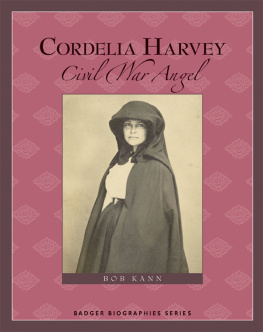Cordelia Harvey

Other Badger Biographies
Belle and Bob La Follette: Partners in Politics
Blue Jenkins: Working for Workers
Caroline Quarlls and the Underground Railroad
Casper Jaggi: Master Swiss Cheese Maker
Cindy Bentley: Spirit of a Champion
Cordelia Harvey: Civil War Angel
Curly Lambeau: Building the Green Bay Packers
Dr. Kate: Angel on Snowshoes
Father Groppi: Marching for Civil Rights
Frank Lloyd Wright and His New American Architecture
Gaylord Nelson: Champion for Our Earth
Harley and the Davidsons: Motorcycle Legends
Joyce Westerman: Baseball Hero
Les Paul: Guitar Wizard
Lucius Fairchild: Civil War Hero
Mai Yas Long Journey
Mary Nohl: A Lifetime in Art
Mountain Wolf Woman: A Ho-Chunk Girlhood
Ole Evinrude and His Outboard Motor
A Recipe for Success: Lizzie Kander and Her Cookbook
Richard Bong: World War II: Flying Ace
Tents, Tigers, and the Ringling Brothers
CORDELIA HARVEY
Civil War Angel
Bob Kann
WISCONSIN HISTORICAL SOCIETY PRESS
Published by the Wisconsin Historical Society Press
Publishers since 1855
2011 by the State Historical Society of Wisconsin
E-book edition 2013
Publication of this book was made possible in part by a grant from the D.C. Everest fellowship fund.
For permission to reuse material from Cordelia Harvey: Civil War Angel (ISBN 978-0-87020-458-6; e-book ISBN 978-0-87020-664-1), please access www.copyright.com or contact the Copyright Clearance Center, Inc. (CCC), 222 Rosewood Drive, Danvers, MA 01923, 978-750-8400. CCC is a not-for-profit organization that provides licenses and registration for a variety of users.
www.wisconsinhistory.org
Photographs identified with WHi are from the Societys collections; address requests to reproduce these photos to the Visual Materials Archivist at Wisconsin Historical Society, 816 State Street, Madison, WI 53706.
Front cover: WHi Image ID 36009.
Cover and interior design by Jill Bremigan
Interior page composition by Biner Design
15 14 13 12 11 1 2 3 4 5
The Library of Congress has cataloged the printed edition as follows:
Kann, Bob.
Cordelia Harvey : Civil War angel / Bob Kann.
p. cm.(Badger biographies)
Includes bibliographical references and index.
ISBN 978-0-87020-458-6 (pbk. : alk. paper) 1. Harvey, Cordelia A. P. (Cordelia Adelaide Perrine), 18241895Juvenile literature. 2. United StatesHistoryCivil War, 18611865WomenJuvenile literature. 3. United StatesHistoryCivil War, 18611865War workJuvenile literature. 4. United StatesHistoryCivil War, 18611865HospitalJuvenile literature. 5. Governors spousesWisconsinBiographyJuvenile literature. 6. WomenWisconsinBiographyJuvenile literature. 7. WisconsinHistoryCivil War, 18611865BiographyJuvenile literature. 8. United StatesHistoryCivil War, 18611865BiographyJuvenile literature. 9. SoldiersServices forWisconsinHistory19th centuryJuvenile literature. 10. OrphanagesWisconsinHistory19th centuryJuvenile literature. I. Title.
E628.K36 2011
973.777092dc22
[B]
2010027443

This book is dedicated to Mary Gallagher, Lilian Eufracio, Dulce Coladilla, and Trinidad Navarro. Thank you for the loving care you provided for my mother, Ann.

Contents

Meet Cordelia

Imagine that you are a soldier in wartime. You are in the hospital because you are very sick or have been wounded in battle. The hospital is more than 500 miles from your home. None of your friends or family can visit you because the war is being fought near your hospital.
You are lying on a in the same room with hundreds of soldiers. Only one doctor is there to take care of everyone. Your only nurses are other sick patients who have no training to care for you.
Youre feeling sad, lonely, and in pain. What might make you feel better? For many Wisconsin soldiers during the , it was Cordelia (kor deel yuh) Harvey. Cordelias job was to help the soldiers. She did her job so well that soldiers often asked for her to come to help take care of them when they were in the hospital.
Cordelia would visit the soldiers, bring them tasty things to eat and drink, say kind words, read letters to them from home, and write letters for them. She convinced the army generals to change the hospital rules so that the sick soldiers received better care. Sometimes she even helped soldiers return home.
Because of her good work, many newspapers called Cordelia the Wisconsin Angel. She did not like the name. She wrote, I am simply doing my & doing very little compared with the great amount there is to be done.
Cordelia did much more than her duty, though. She convinced the president of the United States, Abraham Lincoln, to open a hospital for soldiers in Wisconsin. She also made sure that many children were taken care of after their fathers died in the Civil War. She saved thousands of lives and made many soldiers final days easier. This is the story of how one Wisconsin woman made life better for soldiers and their families in what was perhaps the worst war in United States history.
She Could Run Like a Deer

On December 7, 1824, Cordelia Perrine (pair ruhn) was born in the town of Barre (bair ee) Center, New York. Cordelia was the daughter of John Perrine and Mary Hibbard. She had 5 younger sisters, an older stepsister, and an older stepbrother. The Perrines were related to the royal family of Henry IV of France, who ruled as the king of France from 1589 to 1610.

The Perrin family . The family changed the spelling to Perrine after they moved to the United States.

A view of Southport from Lake Michigan in 1844.
In 1840, the Perrine family moved to Kenosha (kuh noh shuh), Wisconsin, just south of Milwaukee. At the time it was known as Southport. John and Mary became successful farmers. Although she was only 16 years old, Cordelia became a schoolteacher at a school called the Southport Academy.
What was Cordelia like as a teacher? One of her students described her as sometimes behaving like a teenager and at other times acting like a grown-up: At recess time she would in full control.
Louis Harvey was the principal and a teacher at Southport Academy. Louis was born in East Haddam, Connecticut, on July 22, 1820. He attended college for 2 years and then became a teacher in Ohio and Kentucky. Louis moved to Kenosha, Wisconsin, in 1841, where he immediately began working at the Southport Academy.

















